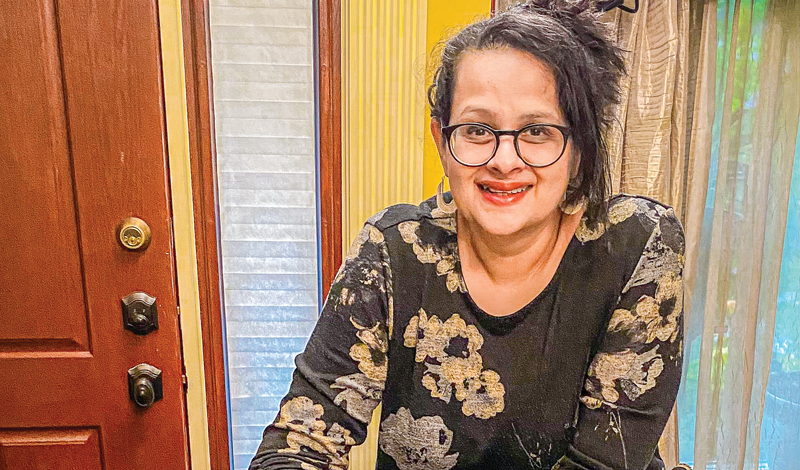by Savita Gilbert
Washington, D.C.
Art speaks where words fail.
At age 10, I began to doodle during conversations. My voice was sunny, but I put on paper how I really felt. Flowers if the conversation was lively, lines and shapes if not. Art was a kind of private dialogue-within-a-dialogue that expressed my deeper feelings and gave a sense of fulfillment.
As I grew up, I continued to express myself through my art, but never showed it to anyone, thinking it wasn’t worthwhile.
As I embraced Buddhist practice, I began to make great strides in my self-confidence. I established a successful law practice and helped many people. Though I continued to sketch and paint and even design clothing, I didn’t entertain any hopes that I could actually make a career of these hobbies. That is, until the pandemic hit and my parents came to live with my husband and me.
In his late 80s, my father was recovering from surgery and needed 24/7 care. Each day, I tried my best, chanting vigorously for his happiness. And yet, each day, he lashed out with harsh words as his faculties declined. Usually, I held my tongue, but a few times, I retorted, burning with indignation and then, immediately, with regret. Instinctively, I turned toward my garden, taking a pen and paper to sketch the flowers. There, though, I worried about my father, batting back feelings of guilt.
How selfish—sketching flowers while your father suffers inside. What are you doing here? Who are you helping?
In 2021, my parents moved out. My father and I stopped talking to each other, and a scolding inner voice told me I was a bad daughter. I was losing focus at work, sinking into a daily depression. Now I turned to my garden for survival, to muster some joy—any joy. After sketching flowers, I painted them. These paintings I printed on fabric, which I cut and stitched to dresses. If I was sketching, painting or designing, I’d find myself smiling. This is what brings me joy, I realized. I continued to chant to awaken my creative energies and put them to work. Soon, I had a small collection of original dresses.
Ikeda Sensei has said that art is intended to lift the human spirit. I had reflected on this for years, but only now, as art lifted me out of depression, did I realize how greatly this guidance applied to me. Few things uplift the spirit like art, yet here I was hiding mine away from the world. I chanted to have the courage to share my art with others—for kosen-rufu, for joy.
In August, I put on a mini fashion show for my neighborhood. I asked a few friends if they’d be willing to wear my dresses and tell how the dresses spoke to them, if at all. They said they felt not just good in the dresses but extraordinarily good. The audience floored me with their praise.
Their encouragement was enough for me to call the organizers of DC Fashion Week, the capital’s most significant fashion show. Late on New Year’s Eve, the show’s executive director called to ask if I could put together 15 pieces in two months—I’d be working with 15 young models. I resolved to help all 15 form a connection with Nam-myoho-renge-kyo.
Each time doubts emerged, I recalled Sensei’s guidance and steeled my resolve. I chanted to bring joy to everyone at the show, starting with the models themselves. When the executive director called again asking if I could do not 15, but 20 pieces, I did not think, Five more pieces? Instead, my heart rejoiced: Five more youth!
I got to know the models personally, their hopes, their dreams, their reasons for modeling. One was from war-fraught Ethiopia, another from Ukraine, another from Russia. One had previously won the title Ms. New Jersey, another, Ms. Virginia. One had been a nurse during the pandemic’s early chaos and was modeling, she said, to heal. Each of these youth was incredible.
Typically, models are trained not to smile on the runway. But I put their names on my altar and chanted for their happiness. On the night of our show, as they lined up in the wings, I went up to each one.
“Please be yourself,” I said. Then I watched them take the stage and bring down the house, looking so happy.
Joyful and proud, I called my father to tell him about the show.
“That’s amazing!” he cried. He then asked how he could invest in my clothing company, which, during all of this, I had jump-started online. The joy of pursuing my passion has opened up not just old lines of communication with my father but new ones. We are speaking again, and our relationship is transforming in new, positive ways.
Through this, I realized something: It doesn’t matter how many acts of virtue I check on a list titled “Things Good People Do.” I must use my life to fulfill my unique mission, because that is what brings me joy and that is how I can bring joy to others.
I’ve stayed in touch with many of these models, some of whom are on some part of their journey in Buddhist practice. To all, I say: Don’t be selfish! Pursue your mission and uplift the human spirit!
from Ikeda Sensei (The Way of Youth, p. 83)
[Art] can encourage us when we are run-down, lift our spirits when we are tense. … Art is the liberation of the humanity inside you.
You are reading {{ meterCount }} of {{ meterMax }} free premium articles

